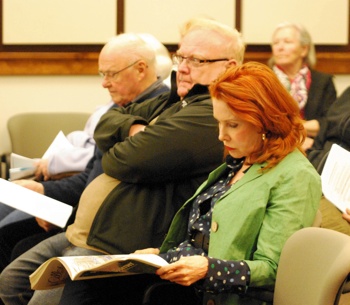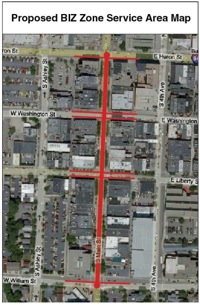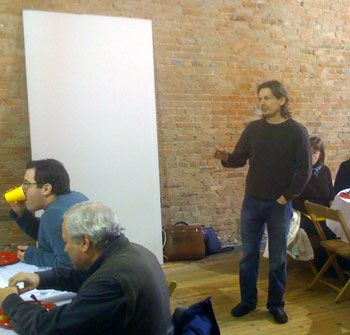Set up is underway for the Rolling Sculpture Car Show. [photo] [photo] Several downtown streets are closed off, so traffic is a bit of a mess.
Stories indexed with the term ‘Main Street’
Downtown Zoning Revisions Move Forward
Ann Arbor planning commission meeting (May 6, 2014): A four-hour meeting was dominated by two topics: revisions to downtown zoning, and the rezoning of land used for public housing.

From left: Ray Detter, Hugh Sonk and Christine Crockett. At the planning commission’s May 6 meeting, they all spoke against a 100-foot height limit for the 425 S. Main site. (Photos by the writer.)
Commissioners voted unanimously to recommend rezoning a large parcel at the southeast corner of Main and William – another step in a review of downtown zoning that began last year under direction from the city council. The recommendation is to rezone the site at 425 S. Main from D1 (downtown core) to D2 (downtown interface), a lower-density zoning. Currently, a two-story 63,150-square-foot office building – where DTE offices are located – stands on the southern part of that site, with a surface parking lot on the north portion.
In a separate action, commissioners were split on adding new requirements to the Main Street character district, where 425 S. Main is located – but that recommendation was approved. The commission voted 6-3 to recommend changes that include setting a maximum height of 100 feet for properties in that district that are zoned D2, and requiring upper story stepbacks from any residential property lines. That maximum is 40 feet taller than the 60-foot height limit specified for D2 zoning elsewhere in the downtown. Dissenting were Sabra Briere, Ken Clein and Jeremy Peters. Briere serves as the city council’s representative to the planning commission.
During deliberations on May 6, Briere pointed out that the 60-foot maximum height had been cited specifically in the city council directive, and she opposed raising that height limit. The 425 S. Main property would be the only D2 site in the Main Street character district, if the city council approves the rezoning recommendation. Because the requirements would apply to just one site, it seemed like spot zoning to Briere.
Neighbors and others had previously raised concerns that D1 zoning – which allows the highest level of density downtown – would result in a negative impact to that part of town, and had supported downzoning to D2. Several neighborhood advocates attended the May 6 meeting and again supported D2 rezoning, but strongly opposed the 100-foot maximum height.
Andy Klein, one of the property owners of 425 S. Main, also attended the meeting, saying that the site would be unbuildable with D2 zoning and a 60-foot height limit, and that the property’s value would be destroyed. He supported the 100-foot maximum.
Members of the commission’s ordinance revisions committee – which brought forward the proposal – defended it, saying that the combination of D2 zoning with a taller height would allow for more flexible design and less massive structures.
At this time, no new development has been proposed for this site. The recommendations approved on May 6 will be forwarded to the city council for consideration. In the coming months, the planning commission’s ordinance revisions committee will tackle other aspects of the council’s downtown zoning directive.
The other major item on the May 6 agenda related to the Ann Arbor Housing Commission, as part of its major initiative to upgrade the city’s public housing units by seeking private investors through low-income housing tax credits. Planning commissioners recommended rezoning for three AAHC properties: (1) Baker Commons, at the southeast corner of Main and Packard, from public land to D2 (downtown interface); (2) Green/Baxter Court Apartments, at the northwest corner of Green and Baxter roads, from public land to R4A (multi-family dwelling district); and (3) Maple Meadows at 800-890 S. Maple, from R1C (single-family dwelling district) to R4B (multi-family dwelling district).
AAHC director Jennifer Hall explained that PL (public land) zoning doesn’t allow housing to be built on it. As AAHC seeks private funding to rehab its properties, it needs to ensure if a building burns down, for example, it could be rebuilt. In general that’s why the rezoning is being requested. It’s also being requested to align the zoning with the current uses of the property. Hall stressed that the highest priority properties to be rezoned are Baker Commons, Green/Baxter and Maple Meadows, because investors have already been found to renovate those sites.
Two other properties were also on the agenda for rezoning: Mallett’s Creek Court, at 2670-2680 S. Main; and 805-807 W. Washington, on the southwest corner of Washington and Mulholland. About a dozen neighbors of Mallett’s Creek Court spoke about concerns that the vacant part of the parcel, adjacent to Cranbrook Park, would be sold or developed. Hall assured them that there’s no intent to sell, and in fact federal regulations that govern pubic housing prevent such a sale. She said AAHC hadn’t been aware that the vacant land, which includes a wooded area, was part of the parcel until they started the rezoning process. There are no plans to develop that side of the parcel.
Neighbors of the West Washington property are concerned about the amount of impervious surface on that site, and chronic flooding problems in that area.
Action on West Washington and Mallett’s Creek Court properties was postponed by the commission. AAHC and city staff will continue to evaluate these two properties, which will likely return to the planning commission for consideration at a later date.
In other action, planning commissioners recommended the annexation of an 0.22-acre lot at 375 Glenwood Street – currently in Scio Township – and to zone the site as R1C (single-family dwelling district), which matches the zoning of surrounding sites. It’s located on the west side of Glenwood, south of Dexter Road.
And commissioners held a public hearing on a master plan update, as part of an annual review process. Only one person – Changming Fan – spoke during the hearing, asking the commission to include his company’s technology in the master plan.
The master plan resolution that commissioners will vote on at their next meeting, on May 20, will highlight work that the commission intends to undertake in the coming year that’s related to master planning efforts. That work includes the Washtenaw Avenue and North Main corridor plans; helping the Ann Arbor Downtown Development Authority develop a streetscape framework; and helping implement the city’s sustainability action plan. [Full Story]
Main & William
Main & Liberty
Holiday lights are being hung in the trees along Main Street. [photo]
Oct. 21, 2013 Ann Arbor Council: Final
The Oct. 21, 2013 meeting of the Ann Arbor city council is the last one before the Nov. 5 election. After the election, the current group of councilmembers will have just one more meeting, on Nov. 7, before the new council is seated. The agenda the current council faces on Oct. 21 is relatively heavy.

The sign on the door to the Ann Arbor city council chamber, installed in the summer of 2013, includes Braille.
It’s possible that the council might be briefed at the meeting on proposals received by the Oct. 18 deadline for the purchase of the city-owned parcel on William Street between Fourth and Fifth avenues (the former Y lot), but that’s not yet clear. The property had been listed for $4.2 million.
Many of the Oct. 21 items already on the agenda can be divided into three main categories: transportation, the Ann Arbor Downtown Development Authority, and the city’s energy commission.
The council held a work session about transportation on Oct. 14, 2013. Transportation-related items on the Oct. 21 agenda include a resolution that would admit Ypsilanti Township as a member of the Ann Arbor Area Transportation Authority. The specific question to be considered is a revision to the AAATA’s articles of incorporation – which would also expand the number of board members from nine to 10.
A second transportation-related agenda item is a city-led initiative to develop a new train station, with the location to be determined. The existing location, as well as one on Fuller Road near the University of Michigan medical campus, would be among the possibilities. On the council’s agenda is a contract with URS Corp. to conduct an environmental review that would include public engagement, site selection and conceptual design. The council’s authorization would be $824,875, an amount that includes a $63,083 contingency. The city would pay 20% of that, or about $165,000, with the rest covered by a federal grant that has already been awarded by the Federal Rail Authority.
To the extent that pedestrian infrastructure is also part of the city’s transportation system, a transportation-related pair of items would alter the definition of “sidewalk” to include cross-lot walkways. Affected by the change, for example, would be walkways that connect streets with parks or school property. The change would allow for use of sidewalk repair millage funds to repair cross-lot walkways, without triggering the winter maintenance requirement for adjacent property owners.
Finally, the city council will be asked to approve an annual resolution related to wintertime transportation – the purchase of ice control salt for city streets.
Related to the Ann Arbor DDA are three items: (1) reconsideration of the appointment of Al McWilliams to the board of that authority – likely to be confirmed on a re-vote, if reconsideration is approved; (2) final consideration of a change to the city ordinance regulating the DDA’s TIF (tax increment financing) capture – likely to be postponed yet again; and (3) a budget allocation of $280,000 to cover costs associated with replacement of downtown ornamental, pedestrian-scale light poles. The DDA is contributing $300,000 to the cost of the $580,000 project. Some councilmembers think the DDA should pay for the full amount, so the eight-vote majority required for the budget amendment might not be achieved.
The specific size of the majority vote required could also be a factor in one of two agenda items related to the city’s energy commission – the re-appointment of Wayne Appleyard to the commission. The confirmation will need a seven-vote majority under the city charter, because he’s not a city resident. The other energy-related item is an energy commission-recommended resolution – which was previously rejected, reconsidered and postponed by the city council. The resolution would call upon the city’s employee retirement board to divest from fossil fuel companies.
This article includes a more detailed preview of each of these agenda items. More details on other meeting agenda items are available on the city’s online Legistar system. Readers can also follow the live meeting proceedings Monday evening on Channel 16, streamed online by Community Television Network.
The Chronicle will be filing live updates from city council chambers during the meeting, published in this article below the preview material. The meeting is scheduled to start at 7 p.m. [Full Story]
DDA OKs Capital Projects, Art Fair Trolley
Ann Arbor Downtown Development Authority monthly board meeting and annual meeting (July 3, 2013): In its voting business, the DDA board allocated a total of $550,000 for capital projects – either planning for future work or actual current projects.

Sandi Smith was elected by her colleagues as chair of the Ann Arbor Downtown Development Authority board at its July 3, 2013 annual meeting. Here she’s showing the DDA’s new website on her tablet. (Photos by the writer.)
The board also approved a $59,200 grant to support the formation of a business improvement zone in the South University area. A “trolley” for the upcoming art fairs also received $10,000 worth of support, in action taken by the board.
The capital projects included $50,000 for repair of sidewalk-related amenities that aren’t covered by the city’s sidewalk millage. In addition, the board allocated $200,000 for a streetscape framework planning project. Board action also included $300,000 for the replacement of light poles on Main Street.
The light pole replacement is one source of current friction between the city and the DDA – as the expectation of the city had been that the entire $516,000 project would be paid for by the DDA. But the result of wrangling over the DDA’s FY 2014 budget – given approval by the council on May 20 – was a transfer of $300,000 from the DDA’s TIF fund to the DDA’s housing fund. So the DDA’s position is that it can’t fund the entire light pole replacement project, because of that transfer to the housing fund.
The light pole question is related to the general issue of DDA finances and the revenue it receives through tax increment finance (TIF) capture of taxes – from entities that levy those taxes in the DDA district. Elected as chair at the annual meeting – which immediately followed the board’s monthly meeting – Sandi Smith will face the resolution of the TIF revenue issue as one of her first challenges.
The outstanding issue concerns the way that the DDA administers Chapter 7 of the city code of Ann Arbor – which regulates the DDA’s TIF capture. This spring the Ann Arbor city council gave initial approval to a revision to Chapter 7. The council’s action, if given final approval, would prevent the DDA from giving the code an interpretation that doesn’t recognize a cap on TIF revenue that is expressed in Chapter 7. The amendment to the ordinance would return several hundred thousand dollars a year to other taxing authorities from which the DDA captures taxes. Those entities include the Ann Arbor District Library, Washtenaw Community College, Washtenaw County and the city of Ann Arbor.
The council has postponed final action on the matter until Sept. 3, 2013. Between now and then, the council’s expectation is that a joint DDA-council committee will meet and make recommendations on the Chapter 7 issue.
At its July 1 meeting, the city council appointed four members to its committee: Christopher Taylor (Ward 3), Stephen Kunselman (Ward 3), Jane Lumm (Ward 2) and Sally Petersen (Ward 2). And at the July 3 monthly meeting, outgoing DDA board chair Leah Gunn appointed the DDA’s committee: Bob Guenzel, Roger Hewitt, Joan Lowenstein and Sandi Smith.
Another point of recent budgetary friction between the city and the DDA was raised briefly at the July 3 board meeting. In a formal resolution, the city council had encouraged the DDA to allocate money to fund downtown beat patrol police officers. For its part, the DDA has for a few years already been mulling the question of some kind of additional security – either in the form of ambassadors, community standards officers or police officers. At the July 3 meeting, DDA board members indicated they would continue to mull that range of options, but seemed disinclined to commit to funding police officers.
The board also heard a range of routine reports on July 3, including the monthly parking revenue report. The DDA manages the city’s public parking system under a contract with the city of Ann Arbor. In the future, it was announced, the report will be delivered only on a quarterly basis. Also related to parking policy, a tentative pilot project was announced that could change the basic approach the DDA takes to selling monthly parking permits. The idea would be to assign permit eligibility only to property owners in a defined geographic area. The number of permits would depend on the number of square feet of property – independent of uses such as office, residential, retail, etc. Currently, the DDA uses a first-come-first-served system for individuals, with a waiting list.
The DDA’s monthly meeting marked a transition on the board, as two board members were bid farewell. Newcombe Clark served one four-year term. He’s making an employment-related move to Chicago. Leah Gunn concluded nearly 22 years of service on the board. She finished out her time on the board as chair. [Full Story]
Ann Arbor Main Street BIZ Clears Hurdle

Map of proposed BIZ area: Main Street from William Street in the south to Huron Street in the north. (Image links to complete .pdf file of the Main Street BIZ plan.)
On Wednesday, a cold and rainy evening, a group of downtown Ann Arbor property owners gathered in the city council chambers for a public meeting gaveled to order by the city clerk, Jackie Beaudry.
They were there not to discuss rain, but rather snow. At least in part.
On their agenda was consideration of a plan for a business improvement zone (BIZ) on Main Street – bounded by William Street to the south and Huron Street to the north – which would assess an extra tax on owners of property in the zone.
That plan for the BIZ includes snow removal as one of three main categories of services to be paid for through the BIZ. The other two categories of service in the plan are sidewalk cleaning and landscape plantings.
The plan was approved on a roll call vote of the property owners in attendance on Wednesday night, but not without some dissent. And the approval of the plan on Wednesday is not the final step before the BIZ can be implemented. Still ahead lies a formal public hearing by the city council, a vote by the city council, followed by another vote by property owners – this one by mail. [Full Story]
In the Business Improvement Zone

A sampling of the questions and ideas generated from a recent meeting of Main Street businesses, who gathered to discuss the concept of a Business Improvement Zone for that area. (Photo by the writer.)
About a dozen business owners, managers and others from the Main Street area gathered last Thursday morning at Conor O’Neill’s to talk about an idea being floated for that district – a self-taxing entity called a business improvement zone, or BIZ. It’s a way to pay for services – things like snow or litter removal, or flowerbeds – to make the district more attractive and bring more shoppers downtown.
This isn’t the first time we’ve encountered the Main Street BIZ. In April, the Downtown Development Authority awarded $83,270 to the group – spearheaded by Ellie Serras and Ed Shaffran – to help get it going. Since then, Main Street BIZ has hired a consultant – Betsy Jackson of The Urban Agenda – and is holding meetings with stakeholders to pitch the idea and get feedback.
That’s what was happening on Thursday. The meeting was one of three planned so far: Earlier in the week, organizers met with property owners of buildings along a three-block stretch of Main Street, where the district is proposed. And on Tuesday, June 30, they’ve scheduled a similar presentation for residents and others who patronize Main Street area businesses. That meeting starts at 6 p.m., also at Conor O’Neill’s. [Full Story]
Building Coworking Space Brick By Brick

Michael Kessler queries potential users of coworking space at 118 S. Main about what they'd commit to and at what price. (Special thanks to Bill Merrill, who lent The Chronicle his camera.)
At noon on Tuesday, around 50 people gathered in the space at 118 S. Main St. to evaluate its potential as a place for coworking by independent operators. Coworking includes income-earning activity that ranges from people working solo in physical proximity with other independent workers, to collaboration with some of them on a single project – without belonging to a common business concern.
But it wasn’t just the physical space that people were keen to see (over a free catered lunch). They also wanted to know what Michael Kessler had in mind for the actual space-use agreements. Kessler has an arrangement with Ed Shaffran, who owns the Goodyear Building which houses the potential coworking space.
So what people wanted to know from Kessler on Tuesday was: What do you get, and how much does it cost? And what Kessler wanted to know from attendees was: Would you actually use this space, and how much would you pay? [Full Story]



